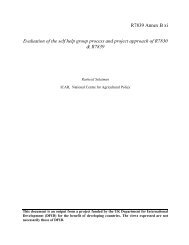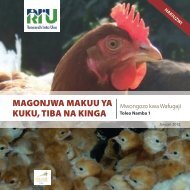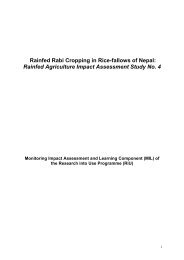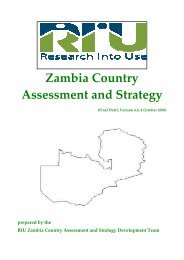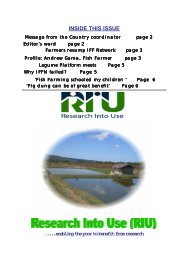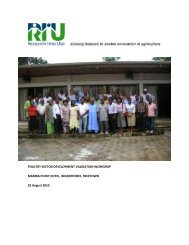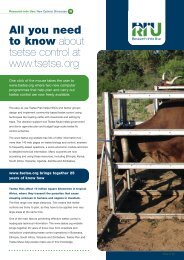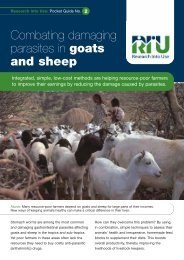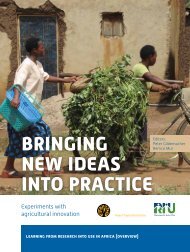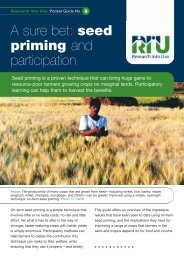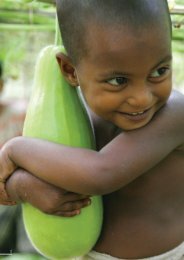Giving seed-yams the credit they deserve RIU Pocket Guide 6
Giving seed-yams the credit they deserve RIU Pocket Guide 6
Giving seed-yams the credit they deserve RIU Pocket Guide 6
You also want an ePaper? Increase the reach of your titles
YUMPU automatically turns print PDFs into web optimized ePapers that Google loves.
much as 10 to 30 percent of <strong>the</strong> tubers <strong>the</strong>yharvest to plant <strong>the</strong> next season. This, in turn,reduces <strong>the</strong> amount of tubers available to eat,sell or process and drives prices even higher.Today <strong>the</strong>re are many people who can no longerafford to eat <strong>yams</strong> for several months of <strong>the</strong> year,when <strong>the</strong>y are scarce—and expensive.Even so, many farmers are reluctant to getinvolved in <strong>the</strong> production of good-quality yamplanting material, which <strong>the</strong>y consider to be arisky business with no immediate returns. This<strong>Pocket</strong> <strong>Guide</strong> shows how farmers can lowercosts and boost quality, making yam available toeveryone year-round.A simple solutionYams are planted using ei<strong>the</strong>r tuber piecesor small tubers that are stored from oneseason to <strong>the</strong> next. A technique is availablethat combines <strong>the</strong> best of <strong>the</strong>se two methodswith <strong>the</strong> use of small amounts of pesticides andfungicides. Using this system, farmers canproduce '<strong>seed</strong>-<strong>yams</strong>'—small tubers that <strong>the</strong>y can<strong>the</strong>n use to plant <strong>the</strong>ir crops—that are free ofpests and diseases.Farmers and researchers worked toge<strong>the</strong>r todevelop and test this simple system. They foundthat when small tuber pieces (known as'minisetts') were dipped in a pesticide solution (acombination of proven fungicides andinsecticides), <strong>the</strong>y survived better and producedmore and bigger <strong>seed</strong>-<strong>yams</strong> than ones preparedusing traditional methods, for instance dustingwith wood ash.Photo: D. CoyneThe biggestproblem is that manyfarmers cannot afford tobuy good-qualityplanting material3
Research into Use: <strong>Pocket</strong> <strong>Guide</strong> No. 66How to produce healthy<strong>seed</strong>-<strong>yams</strong>1. Select good-quality tubers.2. Cut <strong>the</strong> tubers into pieces of 100-150 grams(milk-tin size). (Be sure not to make <strong>the</strong>m toosmall or <strong>the</strong>y may not germinate!)3. Place <strong>the</strong> setts (pieces) in a nylon or plasticnet sack.4. Prepare <strong>the</strong> pesticide dip by mixing:100 grams of Mancozeb70 millilitres of Diazinon10 litres of water.5. Dip <strong>the</strong> setts in <strong>the</strong> mixture for 5-10 minutes.Above: Demand for yam is high in Ghana.Photo: D. Coyne6. Leave <strong>the</strong> pieces to drain and dry for at leasta few hours (preferably overnight).7. Plant <strong>the</strong> setts along ridges separated by adistance of 30-50 cm (about hand-toelbowlength).8. Use <strong>the</strong> harvested <strong>seed</strong>-<strong>yams</strong> <strong>the</strong> followingseason to plant a <strong>seed</strong>-yam crop.Precautions: Be sure that <strong>the</strong> preparers weargloves, eye protection and protective clothing;that <strong>the</strong>y read labels carefully; and that <strong>the</strong>ydispose of excess chemicals carefully. This isvery important!Above: The minisett technique is easy tocommunicate to farmers using simple leaflets likethis one from <strong>the</strong> International Institute for TropicalAgriculture (IITA).
How can I find out more?For more information on <strong>the</strong> minisettsystem, contact <strong>the</strong> <strong>RIU</strong> Programme, NRInternational, Park House, Bradbourne Lane,Aylesford, Kent, UK, ME20 6SN,riuinfo@nrint.co.uk, or Dr LawrenceKenyon, l.kenyon@gre.ac.uk.To learn about experiences withmicro<strong>credit</strong> systems and markets, contactSr Nora McNamara, noramc2006@yahoo.co.uk.In all cases, please copy emails to <strong>RIU</strong>Information (riuinfo@nrint.co.uk).Above and right: Many women sell <strong>yams</strong> atTechiman market, Ghana. Photo: D. CoyneBecause <strong>the</strong> minisettsare planted closetoge<strong>the</strong>r, <strong>the</strong>y makegood use ofscarce land7
About this seriesResearch into Use <strong>Pocket</strong> <strong>Guide</strong>s showcase newtechnologies that have been tried and tested, andhave proven successful in <strong>the</strong> field. They wereproduced to demonstrate <strong>the</strong> importance of highqualityscientific communication.This <strong>Pocket</strong> <strong>Guide</strong> was developed from researchfunded by <strong>the</strong> UK Department for InternationalDevelopment (DFID), Crop Protection Programme(Projects R8416 and R8278). The viewsexpressed are not necessarily those of DFID.<strong>RIU</strong> is managed by Natural ResourcesInternational Ltd., in partnership with NkoolaInstitutional Development Associates Ltd. (NIDA)and Michael Flint and Performance AssessmentResource Centre. <strong>RIU</strong> is funded by DFID.www.researchintouse.comThe <strong>Pocket</strong> <strong>Guide</strong> series was developed, written, designed andprinted for <strong>RIU</strong> by SCRIPTORIA (www.scriptoria.co.uk)



